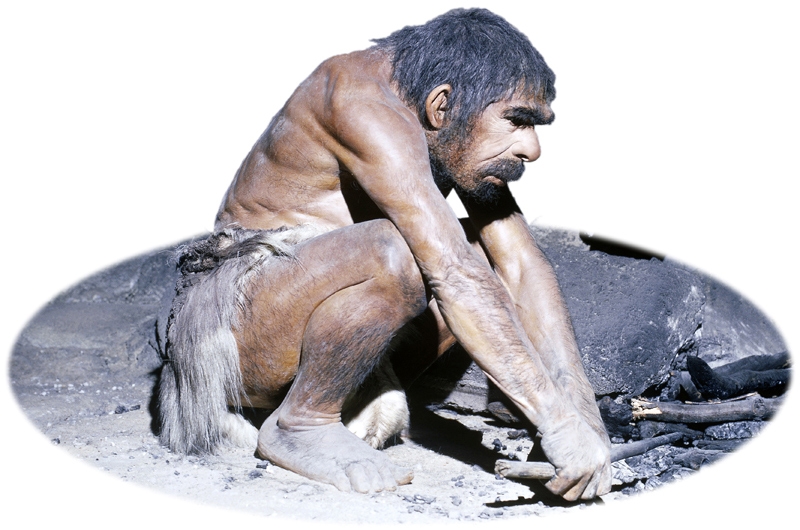The human species that today makes astounding advances in technology, and particularly in the medical field, did not exist four million years ago. In fact, hominids of that period were very different from the modern species in many ways. How did humans evolve to become today’s humans? How did Homo sapiens become so innovative? For one, they developed favorable qualities that were essential for adaptation and a thriving existence.

Homo sapiens derived from a form of early humans called Neanderthal. Unlike modern humans, characteristics of the Neanderthal included occipital buns and protruded brow ridges.1 One important facial feature of the Neanderthal was their large nose for “humidifying and warming cold, dry air” before it reached the lungs.2 Modern humans do not have this characteristic due to the fact that the Neanderthals lived in much harsher conditions. Thanks to the work of archaeologists and anthropologists, we know a great deal about the life and world of Neanderthals. The first fossils of these humans were found in France, and scholars have since called these humans Cro-Magnon. They created innovative tools from bones and antlers for hunting. This enabled them to survive and thrive in their environment. They even created artwork “in the form of decorated tools, beads, ivory carvings of humans and animals, clay figurines, musical instruments, and cave paintings.”3

Homo sapiens originated from East Africa. From there homo sapiens have migrated to all of earth’s main land masses. By taking advantage of land bridges, they have spread to Indonesia, New Guinea, Australia, and the Americas. Another contributing factor to the spreading of humans was the recent major Ice Age. The freezing of the oceans’ waters around the polar caps lowered the sea level, which exposed land bridges between land masses that were otherwise under water. For example, the connection between Calabria and Sicily had a sea level around -126 meters.4 They were able to adapt to the different environments due to their larger brain capacities, hence more intelligence. Having the knowledge that they had, they were able to create warm clothes and shelters to survive under various harsh conditions in the regions they occupied. Since they were nomadic people, there was no economic prosperity during the Paleolithic era. This was due to the fact that they never inhabited an area for a long duration of time. They were foragers; they scrapped up whatever they could find for survival, so there was no time period in which they could accumulate wealth. With that being said, that meant that there were no social classes. Instead, they lived an egalitarian lifestyle. While the men hunted, the women gathered. This method sustained their existence until the Neolithic Revolution, which domesticated both plants and animals.
The evolution of earlier hominids to Homo sapiens opened the door to a species capable of more advanced thinking about their surroundings and survival. The human race has since continued to thrive to the present. Without their innovative tools, body structures, and eventually domestication of plants and animals, Homo sapiens would not have been able to produce the advancements in technology and sciences that we have available today.
- Markus Bastir, Paul O’Higgins, and Antonio Rosas, “Facial Ontogeny in Neanderthals and Modern Humans,” Proceedings of the Royal Society B: Biological Sciences 274, no. 1614 (May 7, 2007): 1125–32. ↵
- Todd C. Rae, Thomas Koppe, and Chris B. Stringer, “The Neanderthal Face Is Not Cold Adapted,” Journal of Human Evolution 60, no. 2 (February 2011): 234–239. ↵
- “Evolution: Humans: Origins of Humankind.” Accessed September 10, 2016. http://www.pbs.org/wgbh/evolution/humans/humankind/o.html. ↵
- Fabrizio Antonioli, V. Lo Presti, M. G. Morticelli, M. A. Mannino, Kurt Lambeck, Luigi Ferranti, Catriona Bonfiglioli, et al., “The Land Bridge between Europe and Sicily over the Past 40 Kyrs: Timing of Emersion and Implications for the Migration of Homo Sapiens,” Rendiconti Online Societa Geologica Italiana, 2012. https://openresearch-repository.anu.edu.au/handle/1885/71477. ↵



99 comments
Jose Fernandez
I really enjoyed reading this article. Even though it is short, it still manages to summarize the most important facts about the Homo Sapiens. I can tell a lot of research was done prior to the creation of this article. I think we should all know about this topic because they are our ancestors after all. It is important to know how much we have evolve. I really liked the title of the article!
Diego Aguilera
Such a great article! It’s incredible how our bodies are able to adapt and evolve for their environment. It was also interesting that an event such as the ice age had an incredible impact on the population making everyone spread across the world. I myself will do more research into the key points of this article as I really liked what this had to say.
Sienna Guerra
I knew some about how humans were evolved but nothing interest me more than how long this evolution took. This article really dug into the roots of humans and provided a good amount of relevant information that was fascinating to learn about. This explanation is amazing to read about and see the boundaries were are evolved into to change for good.
Diego Aguilera
It’s interesting knowing how much humans have changed since the time of Neanderthals. It really makes me wonder if humans may change in the future. It is also interesting knowing all people lived on the same continent. It’s strange knowing how the movements of a few in the beginning changed the future of everyone. I really enjoyed this article and plan to look more into it.
Luke Lopez
This was a very interesting article on the human race. The only humans that survived to this day are the Homo Sapiens. To survive, the Homo Sapiens were innovative and created tools to help them with their tasks, and they also lived an egalitarian lifestyle. This lifestyle consisted of the men hunting and the women gathering. Overall, this was a great article that went into great detail in describing Homo Sapiens.
Lamont Traylor
The history of the human race is so fuzzy because we don’t know for sure what happened and how we came about. We split the possible theories of evolution and creation into two different things. One view is of religion and that everything was put into existence by a god and the other is that people came about by a lucky set of events and then slowly evolved from there.
Damian Jennings
Im always very skeptical about evolution, I believe “In the Beginning, God” not “in the beginning, matter”, I don’t believe we all evolved from a simple celled organism like a bacteria into a human. I believe God put everything here to in a fashionable way, but aside from my beliefs I am very open minded and began reading this article. There is always something to be taken out of a reading. What I admired was the descriptive interpretation of a neanderthal, they were different. They had brow ridges and important facial features that enabled them to withstand cold temperatures and being nomadic really influenced their preference of resting.
Raymond Munoz
Once again I find myself appreciating an article, that I usually wouldn’t read, because of its relevance to the class lectures. My interest was also peaked at the fact that our hominid ancestors would later evolve to gain a greater intelligence and it got me thinking about how we might evolve to better humanity. Now, I’m not a strong believer in evolution, just because I believe God’s hand is forgotten a lot in the explanation of evolution, but I think with the way us humans push our physical and intellectual boundaries we are bound to change for the better some time in the future.
Micaela Cruz
It was very interesting to learn more about how humans have evolved over the course of millions of years. It seems to be a topic that isn’t discussed enough but this article provided a good amount of information relating to the background of how humans came to be. One detail that stood out to me, and one that I found fascinating, was the reasoning behind the Neanderthal people having such big noses. I had never known of this fact, and I am glad I learned something new.
Indhira Mata
I always find it hard to believe that we evolved so much physically and mentally. The article shows how without the past evolution we wouldn’t have been how we are now which is crazy to believe. I learned facts that I didn’t even know about. Like the fact of the big noses to warm the cold air for our lungs. That is a detail that we do not hear in history class at all. It was for their bodies and tools that have gotten us as far as we have gotten because if not we would have been perhaps 200 years behind.